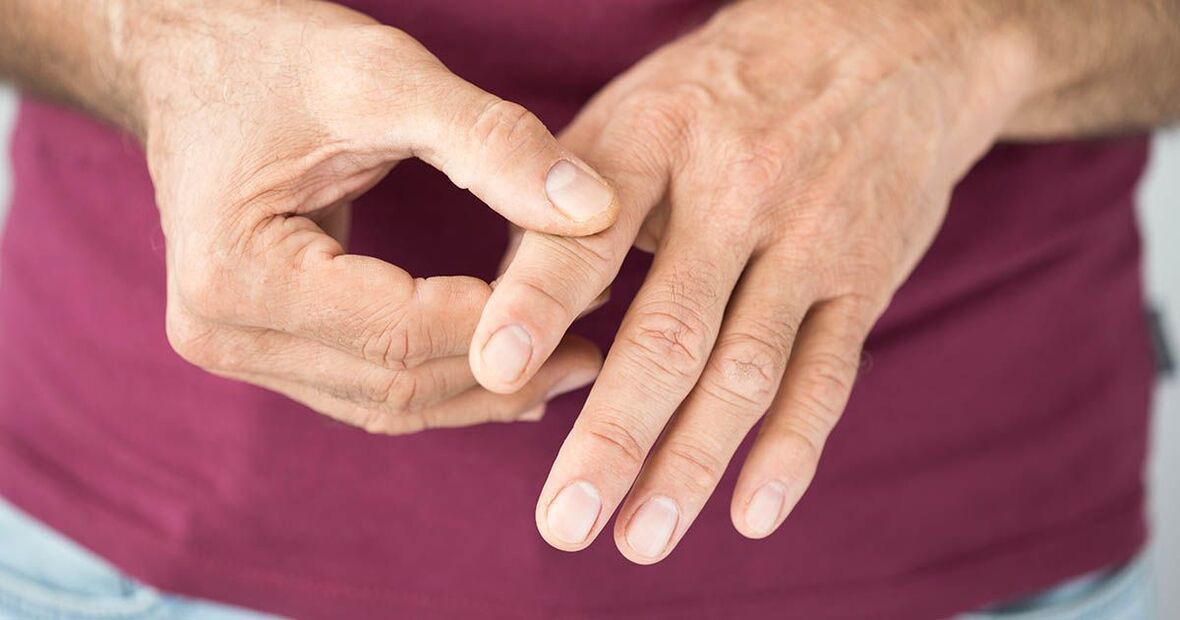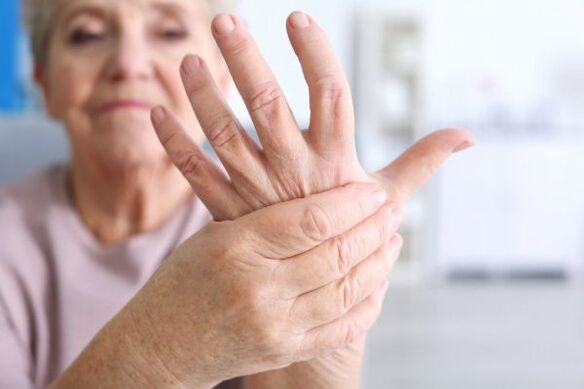
Pain in the fingeroccurs when bones, joints, soft tissues, blood vessels, nerves are affected. It can be dull, acute, weak, intense, persistent, intermittent, short-term. Often there is a connection with motor activity, weather conditions, and other factors. Simultaneous external disturbances are possible: deformation, changes in color and temperature, edema. To determine the cause of pain in the fingers, survey results, external examination, x-ray examination, and other methods are used. Until a diagnosis is made, rest is recommended, sometimes taking painkillers.
Why do fingers hurt
Traumatic injuries
Finger injuries are characterized by moderate pain. Then the intensity of the pain gradually decreases. Edema, hyperemia, cyanosis, bleeding are possible. Finger function is slightly affected. Hematomas on the palmar surface of the fingers are indicated by moderate pain, detachment of the skin with the formation of cavities filled with dark blood. With subungual hematomas, the pain is intense, jerky, throbbing, aggravated by lowering the brush. Partial or complete detachment of the nail plate is possible.
A broken finger is accompanied by severe explosive pain at the time of injury. After that, the pain is somewhat reduced, but still intense. Fingers become blue, swollen, their function is severely violated. Defects, crepitus, pathological mobility can be detected. When the finger is dislocated, a sharp pain is observed. Defective, swollen fingers, when trying to move in the affected joint, spring resistance is determined.
With a cold in the first hour, the pain is slight, tingling. Then the pain syndrome increased, acquiring a burning character. Fingers swell, becoming cyanosis. With deep frostbite, there is no sensitivity in the distal part, the fingers are cold, pale, annoying pain at the border between healthy and affected tissues.
Infectious wounds
Panaritium is characterized by increasing pain, swelling, hyperemia, cyanosis, abscess formation. Pain jerks, throbbing, prevents night sleep. Extremely painful sensations are expressed with subungual panaritium and deep forms of disease (bone, articular, tendon). With superficial forms of panaritium (skin, periungual, subcutaneous, subungual), the general condition suffers little, with symptoms of deep intoxication, fever.
Chinga develops in people engaged in cutting and processing the carcasses of marine game, occurs with minor injuries: abrasions, cuts, cracks. It manifests itself as a dull, weak pain in the wound area, which after 1-2 days is replaced by pain in the finger joints (usually the proximal ones). The pain grows, becomes aching, throbbing, is accompanied by swelling, pallor, cyanosis of the fingers.
Joint pain
Pain in the finger joints in rheumatoid arthritis is symmetrical. 1 degree of activity is indicated by minor arthralgia, rapidly disappearing stiffness. At grade 2, pain is interrupted at rest and during movement, combined with prolonged stiffness, limitation of movement, redness. Grade 3 is characterized by intense persistent pain, persistent stiffness, swelling, hyperemia. Movement is very limited.
Gouty arthritis of the fingers is more common in women. One or more joints may be affected. The pain is usually acute, sharp, combined with edema, hyperemia, impaired function, and a general increase in temperature. Extinguished symptoms are less frequently observed - minor pain and slight redness with a satisfactory general condition.
Psoriatic arthritis occurs suddenly or gradually. In the first case, the pain is moderate, growing, in the second - sharp, intense. At the peak of the disease, the typical picture includes pain, worsening at night and at rest, weakening during the day, with movement, swelling of the fingers, purplish-bluish color of the skin. The distal interphalangeal joint is most often affected. Over time, various deformations appear.
In post -traumatic arthritis, one joint is affected. For infectious-allergic forms of disease, developing against a background of bacterial and viral infections, multiple lesions are typical. With professional peripheral arthritis, the most burdened finger joints are involved in the process. Pain in all the listed pathological forms is increasing at night, weakening during the day, and is compounded by morning stiffness, localized swelling, and difficulty in movement. With a long course, deformation is observed.

Degenerative pathology
With hand arthrosis, the pain is initially uncertain, periodic, short -lived. There is morning stiffness. Thereafter, the painful sensations intensify, become prolonged, sometimes burning, are observed with any movement, limit daily activities, and perform delicate operations. Heberden and Bouchard nodes are formed. Change the shape of the formed side.
Diseases of the ligaments and tendons
Patients with stenosing ligamentitis worry about pain along the surface of the palm of the hand at the base of the affected finger. At first, the pain syndrome appears only with small pressure and movements, then it remains at rest. Movement is limited, accompanied by one click. Over time, the flexion contracture develops, after one click, pain is given to the arm.
In the early stages, de Quervain's disease is indicated by pain during abduction, hyperextension of the first finger. After that, aching, depressing pain occurs with any physical activity, some patients are disturbed even at rest. Normal irradiation to the distal phalanx or to the forearm from the side of the first finger.
Angiotrophoneurosis
Raynaud's syndrome is caused by vasospasm, accompanied by paroxysmal numbness, cold fingers. Pain occurs in the second phase of the attack, has a ruptured character, combined with a burning sensation, satiety. The pain syndrome is short -lived, replaced by a feeling of heat, redness of the distal part of the hand. Pathology occurs in a variety of diseases of various origins, including:
- rheumatoid arthritis;
- systemic lupus erythematosus;
- scleroderma;
- Sharp syndrome;
- antisynthetase syndrome;
- thromboangiitis obliterans of the upper part;
- endocrine, metabolic, occupational pathology.
If no other disease triggers this condition, they are talking about Raynaud’s disease with a similar pain syndrome. This form is more common in women.
Erythromelalgia occurs independently or is formed in patients with endocrine, neurological, hematological diseases. It is indicated by paroxysmal attacks of baking, burning pain, edema, hyperemia of the fingers. It is possible for pain to spread from one limb to another or occur simultaneously in the area of both limbs. The attack of pain is so strong that it interferes with any movement. The pain is reduced by cooling and lifting the hand, increasing by warming and lowering the hand.
Neurological pathology
Pain in the fingers occurs when nerves are damaged, spread in the conservation zone, have a shooting or burning character, are accompanied by sensory disturbances, autonomic-trophic disorders. Possible neurological causes:
- Median nerve neuropathy.The pain is localized on the palms of fingers I-III, combined with the inability to bend the fingers, clenching the fists into the fists, opposing the I fingers.
- carpal tunnel syndrome.A type of median nerve neuropathy caused by compression of nerve fibers at the level of the wrist. Localization of pain - as in the previous case. Normal night attacks, decrease in pain when lowering the arm, shaking the brush.
- Radial nerve neuropathy.With lesions at the level of the forearm and wrist, pain is observed along the posterior surface of the first finger and hand, sometimes spreading to the second and third fingers. Radiation in the forearms, numbness of the back of the hands are characteristic.
- Ulnar nerve neuropathy.Localized pain mainly in the elbow joint area, but can spread to the hands, fingers IV-V. Pain syndromes often increase in the morning.
Tumor
Benign tumors that affect the finger bones include chondroma and osteoid osteomas. Chondromas are manifested by a non -intense pain sensation with unclear localization, osteoid osteomas - by sharp pain in the affected area. Malignant neoplasia of the fingers is rare.
Another reason
Pain in the fingers and hands is observed in patients with writing spasms, which develop with occupational neurosis, some mental and other neurological disorders. Pain occurs when writing, working on a computer or typewriter. They break, pull, are equipped with trembling, sudden weakness of the hands, local seizures. In addition, pain in the fingers can be detected in the following pathologies:
- Leukemia: Macroglobulinemia Waldenström.
- Tumors of the adrenal glands: aldosteroma.
- Complications of diabetes: diabetic neuropathy.
- Vascular disease: distal digital embolism due to obstruction of the subclavian artery.
- hereditary disease: Fabry disease.
- Childhood diseases: neuro-arthritis diathesis.
Diagnostics
Trauma-orthopedic specialists are involved in determining the cause of pain in the fingers. Diagnosis is made based on conversations with patients, external examination data, additional studies. Diagnostic programs include:
- Review. The doctor knows when and under what circumstances the pain syndrome and other symptoms first appear, determines the dynamic features of disease progression, the factors that give rise to an increase or deterioration in the patient's condition. Study life history, family history.
- Physical examination. Specialists assess the appearance of the fingers, revealing defects, inflammation, cracks, dry skin, temperature and color disorders, swelling, and other pathological manifestations. Check sensitivity, range of motion, pulse in peripheral arteries.
- Radiography.It is performed in two projections by capturing the affected finger or the whole hand. Confirms the presence of fractures, dislocations, tumors, inflammatory and degenerative processes, areas of destruction of solid structures in the form of deep panaritium.
- Electrophysiological studies.They are performed for nerve origin pain to clarify the degree of nerve damage, assess muscle condition, and nerve conduction.
- Lab test. Produced to determine inflammation, assess the general condition of the body, detect specific markers in collagenose.
According to the indications, patients were referred for consultation with endocrinologists, neurologists, vascular surgeons, and other specialists. Provide CT, MRI, other instrumental techniques. Perform hard and soft structure biopsies for cytological or histological examination.

Treatment
first aid
In case of traumatic injury, cold, elevated limb position is recommended. Hands are tied with fragments or artificial materials (e. g. , boards). A raised brush or a scarf is used. With intense pain syndrome, analgesics are given, if there is no external damage, clooethyl is used.
Relief for the disease is determined by the nature of the pathology - changes in limb position, warming or, conversely, cooling can help. The most common measure is rest, however, in some diseases (carpal tunnel syndrome, arthritis), the pain syndrome is reduced while maintaining motor activity. Acute wrinkling pain, significant signs of inflammation, general hyperthermia are reasons for immediate consultation with a specialist.
Conservative therapy
In cases of dislocations and fractures, local anesthesia is performed, reduction is performed, and plaster casts are applied. Conservative treatment of traumatic and non -traumatic pathology of the finger involves the following activities:
- Protection mode. It is selected taking into account the nature and severity of the disease. Possible recommendations for limiting the load, the use of orthopedic devices, the imposition of plaster casts.
- Medical therapy. Non-steroidal anti-inflammatory drugs, antibiotics, drugs to improve blood circulation, neurotropic drugs are used. According to the instructions, blockade with corticosteroids was performed.
- Non -drug methods. Exercise therapy, massage, physiotherapy, manual therapy, kinesio recordings are prescribed.
Surgical intervention
Surgery is performed when conservative methods are ineffective, to reduce time and improve long -term treatment outcomes. Taking into account the characteristics of the lesion, the following is carried out:
- injuries: fixation of fractures and dislocations with knitting needles, necrectomy and amputation of fingers in case of frostbite.
- Contagious disease: opening, panaritium drainage, in case of severe lesions in some cases - amputation or articulated.
- Diseases of tendons and ligaments: dorsal ligament surgery and adhesion resection in de Quervain’s disease, annulus ligament surgery in stenosing ligamentitis.
- Neoplasm: removal of neoplasia, bone resection.
- Nerve disease: nerve decompression.
After surgery, antibiotic therapy is prescribed. The patient undergoes a comprehensive rehabilitation aimed at maximizing the recovery of hand function.



















